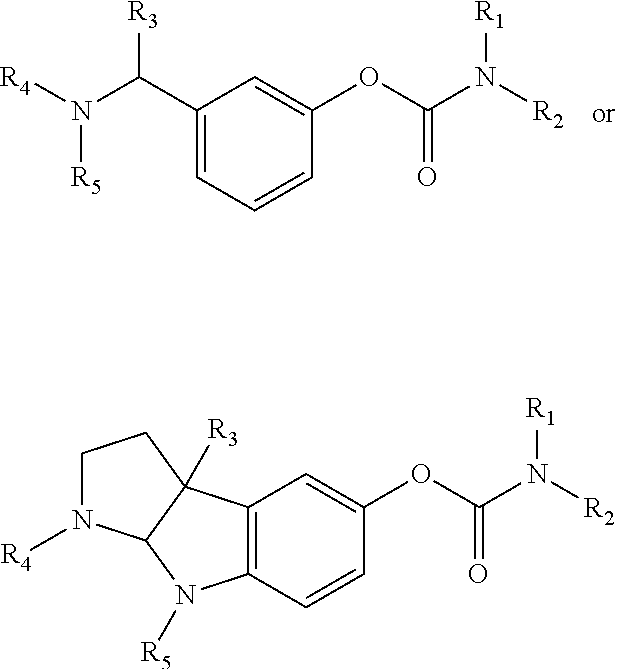Stigmine Conjugates for Substance Use Disorders
a technology of conjugates and substance use disorders, applied in the direction of biocide, cardiovascular disorders, drug compositions, etc., can solve the problems of large number of legal and illicit drugs, prescription medicines have abuse liability, experience unpleasant physical and psychological symptoms, etc., to reduce craving, block the reinforcing effect of abused drugs, and reduce abuse potential
- Summary
- Abstract
- Description
- Claims
- Application Information
AI Technical Summary
Benefits of technology
Problems solved by technology
Method used
Image
Examples
example 1
Synthesis of S-riva-atomoxetine (5)
[0110](S)-(−)-3′-hydroxyphenylethyldimethylamine (96 mg, 0.58 mmol) (1) was dissolved in 4 ml of dry ethyl acetate. N,N′-carbonyldiimidazole powder (283 mg , 1.74 mmol) was added and the mixture stirred at room temperature for 20 h. Acetic acid (313 mg, 5.22 mmol) was then added to the mixture, followed by the addition of 162 mg (−)-atomoxetine (4, 0.63 mmol). The resulting mixture was stirred at room temperature overnight. Saturated sodium bicarbonate solution was added to the mixture and the aqueous and organic layers separated. The aqueous layer was extracted twice with ethyl acetate. The organic layers were combined, dried over NaHCO3, evaporated and purified with a silica gel column (eluted with 25% ethyl acetate in hexane with 1% triethylamine) to yield 101 mg of the carbamoyl ester (5) (0.23 mmol, 39.0% yield).
[0111]The carbamoyl ester (5) was confirmed by NMR. 1H-NMR of the HCl salt (CDCl3, 400 MHz): δ 1.808 and 1.825 (d, 3H, J=6.8 Hz, CH3)...
example 2
Synthesis of S-riva-l-methamphetamine (7)
[0114]4-nitrophenychloroformate powder (0.179 g, 0.86 mmol) was added to a solution of 0.12 g (0.72 mmol) (−)-3′-hydroxyphenylethyldimethylamine (1) and 0.22g (2.17 mmol) triethylamine in 10 ml of dry dichloromethane (0.86 mmol) at 0° C. The solution was stirred at 0° C. for 5 min followed by stirring at room temperature for an additional 30 minutes. A solution of 0.107 g 1-methamphetamine (6) in 2 ml of dry dichloromethane was then added, and the resulting solution stirred at room temperature for 2 hours. The solvent was evaporated and the residue applied to a silica gel column. The compound (7) was eluted with 3% acetone in ethyl acetate containing 1% triethylamine. Fractions containing compound (7) were combined and concentrated to yield 0.15 g of the compound (7) (0.44 mmol, 61% yield).
[0115]The compound (7) was confirmed by NMR. 1H-NMR (CDCl3, 300 MHz): δ 1.192 (mi) and 1.275 (ma) (d, 3H, J=6.8 Hz, CH3), 1.305 and 1.326 (d, 3H, J=3.0 Hz,...
example 3a
Synthesis of S-riva-l-amphetamine (9)
[0116]At room temperature, diisopropylethylamine (5.16 g, 40 mmol) and CDI powder (6.48 g, 40 mmol) were added to a suspension of 7.34 g of 1-amphetamine sulfate (8) (40 mmol) in 140 ml of dichloromethane. The resulting mixture was stirred at room temperature for 1 h. (−)-α-3′-hydroxyphenylethyldimethylamine (1) (3.3 g, 20 mmol), which had been mixed with 0.8 g sodium hydride (60% dispersion in mineral oil) in dry toluene (120 ml) for 30 minutes, was added to the mixture and the dichloromethane removed under reduced pressure. The resulting suspension was heated to 85° C. overnight with stirring. The reaction mixture was extracted with 0.5 M HCl (200 ml). The aqueous layer was washed with ethyl acetate, basified at 0° C. to pH ˜11 with sodium bicarbonate and 0.5 N NaOH and extracted with ethyl acetate (3×100 ml). The organic layers were combined, dried over sodium sulfate and evaporated. The residue was purified with a silica gel column. Elution w...
PUM
| Property | Measurement | Unit |
|---|---|---|
| temperature | aaaaa | aaaaa |
| blood pressure | aaaaa | aaaaa |
| physical | aaaaa | aaaaa |
Abstract
Description
Claims
Application Information
 Login to View More
Login to View More - R&D
- Intellectual Property
- Life Sciences
- Materials
- Tech Scout
- Unparalleled Data Quality
- Higher Quality Content
- 60% Fewer Hallucinations
Browse by: Latest US Patents, China's latest patents, Technical Efficacy Thesaurus, Application Domain, Technology Topic, Popular Technical Reports.
© 2025 PatSnap. All rights reserved.Legal|Privacy policy|Modern Slavery Act Transparency Statement|Sitemap|About US| Contact US: help@patsnap.com



